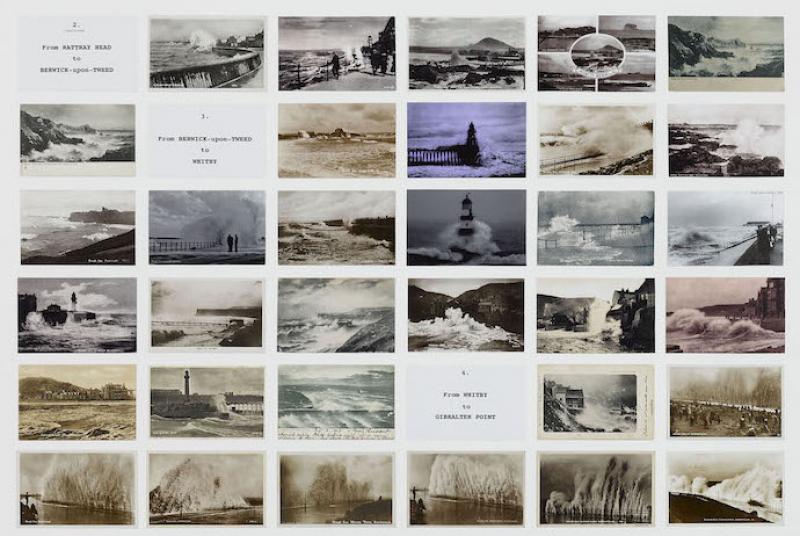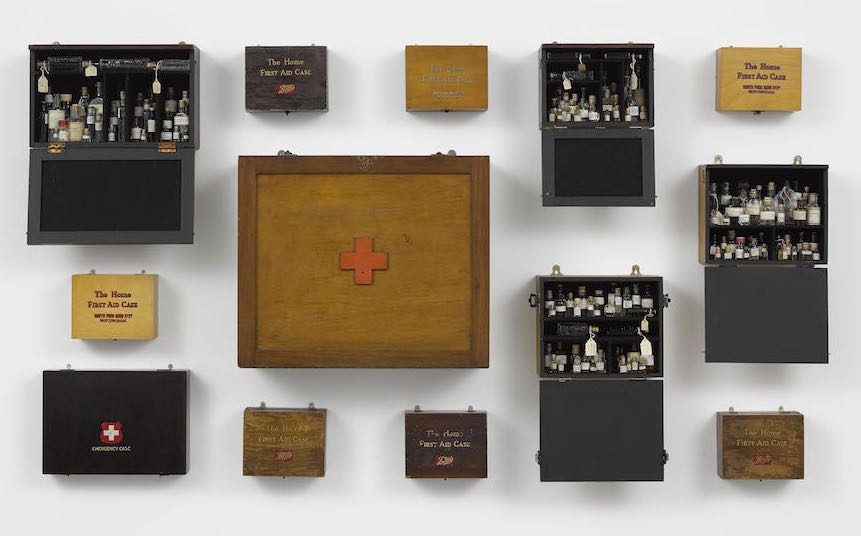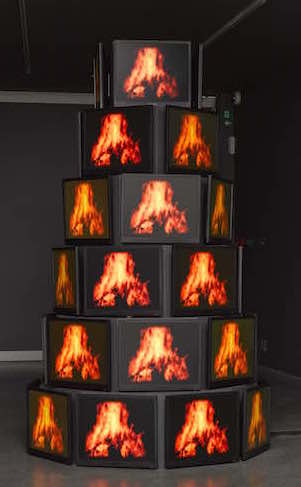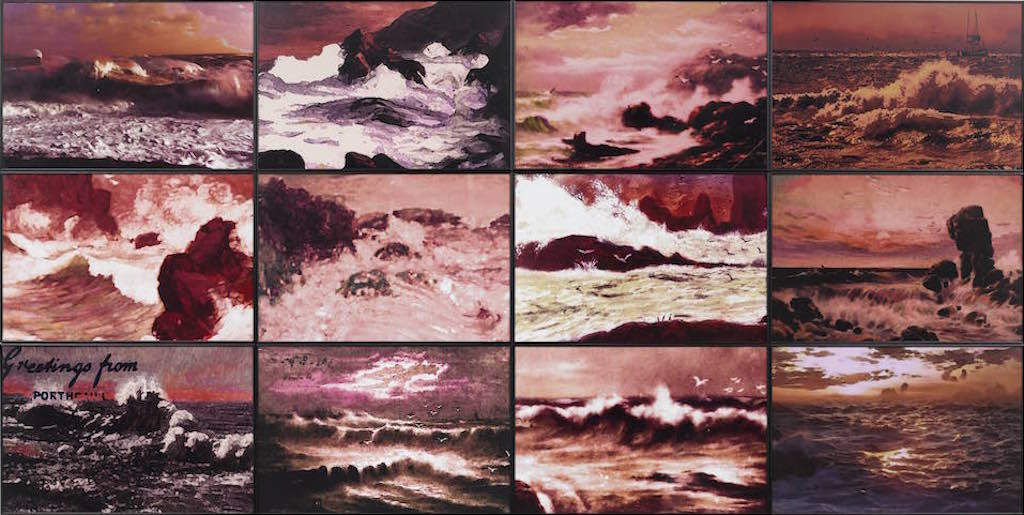Susan Hiller, Lisson Gallery | reviews, news & interviews
Susan Hiller, Lisson Gallery
Susan Hiller, Lisson Gallery
An artist fascinated by the wild, the untamed and the paranormal

This is Susan Hiller’s first exhibition since her Tate retrospective in 2011, and as it includes work from the 1970s to the present, it can also be seen as a retrospective of sorts. But since the selection was obviously governed by what was available for sale, it inevitably offers a piecemeal view of her achievements.
Nor can I do full justice to the work, which is complex and multi-layered, so I’ll concentrate on one aspect – the importance of unorthodox views and marginal voices (especially those of women who have been silenced for centuries) that challenge the hegemony of received opinion and rational thought. “The world is ruled by cast-iron laws, unbelievably boring,” declares a voice (in Russian) on the soundtrack of a film in her installation Wild Talents, 1997. “There is no telepathy, no ghosts, no flying saucers – they can’t exist... Don’t you feel the dreadful tedium of such an assertion?” Hiller evidently does, since she goes to great lengths to seek out the irrational and inexplicable.
The title of her installation is borrowed from a book by Charles Fort exploring the phenomenon of children who demonstrate extraordinary psychic powers. Clips from feature films show angelic young blondes breaking glass, bringing water to the boil and setting people on fire solely through the power of their gaze. Meanwhile a boy unleashes vast jets of water that surge cataclysmically through city streets, and another watches, in horror, his toys come to belligerent life. But whereas the boys seem at the mercy of their unnerving powers, the girls are clearly in control. The boys are innocent, the girls demonic; but that’s another story.
 An acceptance of paranormal activity is not restricted to Hollywood, of course. Religious belief is often sustained by inexplicable happenings. On a small monitor strung with votive lights, a black and white documentary follows pilgrims on their way to meet children who have had authenticated religious visions.
An acceptance of paranormal activity is not restricted to Hollywood, of course. Religious belief is often sustained by inexplicable happenings. On a small monitor strung with votive lights, a black and white documentary follows pilgrims on their way to meet children who have had authenticated religious visions.
According to one argument, our faith in science and medicine elevates them to the status of a religion. One of the best pieces in the show, Emergency Case: Homage to Joseph Beuys, 2012 (pictured above), juxtaposes outdated first-aid kits with cabinets crammed with phials of holy water collected from shrines as far afield as Egypt, New Mexico, Jordan, Italy, Scotland, Turkey and Greece. The work seems to imply that faith in the remedy – whether it be valid or misguided – is important as an aid to healing.
Generally speaking, though, people can be divided into two camps – those who view paranormal phenomena as delusional nonsense and those who regard them as welcome proof that, in a world increasingly governed by reason, the marvellous still persists. Having studied anthropology, Hiller assumes the guise of a dispassionate observer, collecting and analysing data and presenting her findings as artworks rather than as research papers; since her preoccupation has lasted over 40 years, it seems safe to assume that the wondrous holds a deep fascination for her. This is where I have problems with the work; scepticism about her subject matter undermines my enjoyment of it.
Take her recent video Resounding (Infrared), 2013. Visually it is very beautiful; horizontal bands of vivid colour resembling batik are accompanied by a soundtrack of cosmic background radiation – fallout, we are told, from the Big Bang – and the testimonies of people who claim to have seen UFOs and other bright lights in the sky.
 Shown on a pyramid of monitors, her video Belshazzar’s Feast, 1983 (pictured right) features the flickering flames of a campfire. On the soundtrack, her young son recalls the biblical story of a warning being miraculously written on the wall during Belshazzar’s feast, and Rembrandt’s painting of the event. Hiller improvises some trance-like keening and, in an urgent whisper, recounts newspaper reports of ghostly images appearing on people’s television screens after close-down.
Shown on a pyramid of monitors, her video Belshazzar’s Feast, 1983 (pictured right) features the flickering flames of a campfire. On the soundtrack, her young son recalls the biblical story of a warning being miraculously written on the wall during Belshazzar’s feast, and Rembrandt’s painting of the event. Hiller improvises some trance-like keening and, in an urgent whisper, recounts newspaper reports of ghostly images appearing on people’s television screens after close-down.
Both videos are mesmeric but if, like me, you take with a pinch of salt the claims they report, it makes it hard to embrace Hiller’s degree of engagement with the subject, no matter how serious her intentions. It is possible, of course, to persuade an audience to suspend their disbelief. She achieved this in Witness, 2000, an installation of 600 small speakers dangling from the ceiling, through which one hears people describing encounters with UFOs. Their whispered certainties are so compelling that all scepticism melts away; unfortunately, though, the piece is not included in the show.
One glorious series, which elicits no such doubts, also records people’s fascination with an uninvited and potentially dangerous guest – the sea. Ever since the 1970s, Hiller has collected postcards portraying huge waves battering the coastline of Britain. Some images appear several times in different versions, some are obviously fanciful, others have been enhanced, but all testify to our ambivalent relationship with the element that surrounds our island and threatens our wellbeing while keeping us safe from invaders.
 On the Edge, 2015, (main picture) revisits the subject in 482 postcards sorted according to location around the coast and presented in a series of grids. This arrangement is as pleasing and as reassuring as the shipping forecast – perhaps because it reiterates our boundaries, or perhaps because it provides proof that there are things we have singularly failed to control, despite our arrogant attempts at mastery and our belief that the planet is our playground (pictured above: Rough Dawns, 2015).
On the Edge, 2015, (main picture) revisits the subject in 482 postcards sorted according to location around the coast and presented in a series of grids. This arrangement is as pleasing and as reassuring as the shipping forecast – perhaps because it reiterates our boundaries, or perhaps because it provides proof that there are things we have singularly failed to control, despite our arrogant attempts at mastery and our belief that the planet is our playground (pictured above: Rough Dawns, 2015).
In understanding this, perhaps I have gone some way to explain the fascination that UFOs and paranormal happenings have for Susan Hiller and many others. It's a shame that I don’t share it.
rating
Explore topics
Share this article
The future of Arts Journalism
You can stop theartsdesk.com closing!
We urgently need financing to survive. Our fundraising drive has thus far raised £49,000 but we need to reach £100,000 or we will be forced to close. Please contribute here: https://gofund.me/c3f6033d
And if you can forward this information to anyone who might assist, we’d be grateful.

Subscribe to theartsdesk.com
Thank you for continuing to read our work on theartsdesk.com. For unlimited access to every article in its entirety, including our archive of more than 15,000 pieces, we're asking for £5 per month or £40 per year. We feel it's a very good deal, and hope you do too.
To take a subscription now simply click here.
And if you're looking for that extra gift for a friend or family member, why not treat them to a theartsdesk.com gift subscription?
more Visual arts
 'We are bowled over!' Thank you for your messages of love and support
Much-appreciated words of commendation from readers and the cultural community
'We are bowled over!' Thank you for your messages of love and support
Much-appreciated words of commendation from readers and the cultural community
 Lee Miller, Tate Britain review - an extraordinary career that remains an enigma
Fashion photographer, artist or war reporter; will the real Lee Miller please step forward?
Lee Miller, Tate Britain review - an extraordinary career that remains an enigma
Fashion photographer, artist or war reporter; will the real Lee Miller please step forward?
 Kerry James Marshall: The Histories, Royal Academy review - a triumphant celebration of blackness
Room after room of glorious paintings
Kerry James Marshall: The Histories, Royal Academy review - a triumphant celebration of blackness
Room after room of glorious paintings
 Folkestone Triennial 2025 - landscape, seascape, art lovers' escape
Locally rooted festival brings home many but not all global concerns
Folkestone Triennial 2025 - landscape, seascape, art lovers' escape
Locally rooted festival brings home many but not all global concerns
 Sir Brian Clarke (1953-2025) - a personal tribute
Remembering an artist with a gift for the transcendent
Sir Brian Clarke (1953-2025) - a personal tribute
Remembering an artist with a gift for the transcendent
 Emily Kam Kngwarray, Tate Modern review - glimpses of another world
Pictures that are an affirmation of belonging
Emily Kam Kngwarray, Tate Modern review - glimpses of another world
Pictures that are an affirmation of belonging
 Kiefer / Van Gogh, Royal Academy review - a pairing of opposites
Small scale intensity meets large scale melodrama
Kiefer / Van Gogh, Royal Academy review - a pairing of opposites
Small scale intensity meets large scale melodrama
 Jenny Saville: The Anatomy of Painting, National Portrait Gallery review - a protégé losing her way
A brilliant painter in search of a worthwhile subject
Jenny Saville: The Anatomy of Painting, National Portrait Gallery review - a protégé losing her way
A brilliant painter in search of a worthwhile subject
 Abstract Erotic, Courtauld Gallery review - sculpture that is sensuous, funny and subversive
Testing the boundaries of good taste, and winning
Abstract Erotic, Courtauld Gallery review - sculpture that is sensuous, funny and subversive
Testing the boundaries of good taste, and winning
 Edward Burra, Tate Britain review - watercolour made mainstream
Social satire with a nasty bite
Edward Burra, Tate Britain review - watercolour made mainstream
Social satire with a nasty bite
 Ithell Colquhoun, Tate Britain review - revelations of a weird and wonderful world
Emanations from the unconscious
Ithell Colquhoun, Tate Britain review - revelations of a weird and wonderful world
Emanations from the unconscious
 Rachel Jones: Gated Canyons, Dulwich Picture Gallery review - teeth with a real bite
Mouths have never looked so good
Rachel Jones: Gated Canyons, Dulwich Picture Gallery review - teeth with a real bite
Mouths have never looked so good

Add comment